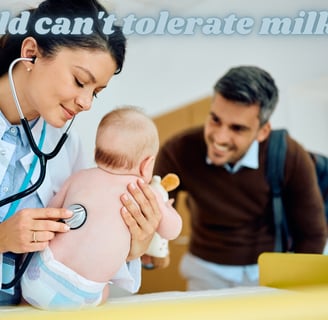My child can't tolerate milk!
T. A.
2/26/20255 min read


Pediatricians often hear this from parents. However, there is sometimes confusion about the topic. It is important that you first understand that there are intolerances to cow's milk that involve our immune system and those that have nothing to do with the immune system - this is about cow's milk allergy or lactose intolerance.
Don't confuse: cow's milk allergy and lactose intolerance
The immune system is not involved in lactose intolerance. The disaccharide lactose cannot be broken down or can only be broken down incompletely by the enzyme responsible for breaking down lactose in the small intestine. The result is that undigested lactose reaches the large intestine and serves as "food" for the bacteria there. This produces gases and the stool becomes softer or more liquid - unpleasant, but not bad.
Lactose has a bad reputation, but it is a prebiotic that occurs naturally in breast milk. Lactose is the main carbohydrate in breast milk. Only in extremely rare cases (in the case of a congenital enzyme defect) is it necessary to feed babies a lactose-free or low-lactose diet. This is also the reason why genetic tests for "lactose intolerance" in babies and small children are completely unnecessary. Even in people with a genetic lactose intolerance, the enzyme in the small intestine is completely intact up to the age of 5 and only from school age does the activity of the enzyme decrease, as is the case with older people. Then you may have to resort to low-lactose products or concentrate more on fermented milk products. Completely avoiding cow's milk is almost never necessary if you are lactose intolerant.
Cow's milk allergy: one to two percent of all babies in Germany are affected
This is different with a cow's milk allergy. Here the immune system is activated by contact with cow's milk protein. Cow's milk can come from baby formula, which is usually made with cow's milk protein, but also from breast milk, as cow's milk protein consumed by a breastfeeding mother can pass into breast milk in small amounts.
The immune system then either activates so-called IgE antibodies or reacts allergically in another way and produces a "non-IgE-mediated cow's milk allergy".
A cow's milk allergy occurs in around one to two percent of all babies in Germany. It is common in other countries, but much less common in Greece, for example. A cow's milk allergy often occurs in the first year of life, after which it becomes increasingly rare.
A cow's milk allergy can cause a wide range of symptoms. The symptoms of a cow's milk allergy are very diverse. Rarely is the well-known IgE-mediated cow's milk allergy overlooked. The babies react with an acute rash, swollen eyes, thick lips and occasionally shortness of breath.
The diagnosis is made via a blood test or - less frequently in infants - via a skin test and the babies must then be fed a strictly cow's milk protein-free diet. This requires foods in which the cow's milk protein is broken down into such small building blocks that the body no longer recognizes the protein as cow's milk protein. The term "extensively hydrolyzed foods" (eHF) refers to these foods. In severe cases, amino acid-based foods (AAF) are recommended. The costs of these foods are covered by health insurance and can be purchased from a pharmacy. A HA food sold in drugstores is not sufficient in these cases.
The non-IgE-mediated cow's milk allergy, on the other hand, is not always easy to recognize.
Diagnosis of a non-IgE-mediated cow's milk allergy is more difficult
Cow's milk allergies that are not caused by IgE are frequently less severe. Skin rashes, flatulence, increased spitting, colic, constipation, diarrhea, or even bloody stools may accompany these. The varied picture of symptoms sometimes makes it difficult to arrive at a diagnosis, which is why an evaluation scheme (CoMiSS®) was developed to rate symptoms with points and ultimately obtain a certain probability of cow's milk allergy. If the probability is increased, further diagnosis is necessary to confirm the cow's milk allergy.
When it comes to this kind of allergy, laboratory tests aren't very helpful. The cow's milk IgE antibodies can, but do not have to, be positive. Even if no antibodies are detected, a cow's milk allergy cannot be ruled out. The diagnosis is only confirmed when the symptoms improve significantly during an elimination diet with an eHF or AAF special diet for 2-4 weeks. The special foods will be covered by health insurance companies regardless of laboratory results if this is the case. Fortunately, non-IgE-mediated cow's milk allergies have a better prognosis than IgE-mediated allergies do. After the first year of life, most children can tolerate cow's milk again. It is also pleasing that "dietary errors" are less serious because they cause less dramatic symptoms.




The reaction of bloody stools, which parents find especially alarming, is typically harmless and goes away quickly, frequently as soon as additional food is introduced.
Prognosis for a cow's milk allergy: promising prospects The prognosis is good in the long term, but there are certainly children who still have to be fed cow's milk-free food at kindergarten age. The families of these children need information and training on how to deal with a possible allergic reaction, including prescriptions and training on emergency equipment. The caregivers in the kindergarten may also need to be trained and all adults who look after these children should know what to do and who to inform in an emergency.
Before milk is reintroduced to children who have experienced a classic allergic reaction, a food challenge, typically performed in a hospital, is required. Finally, one final note: Despite all the concerns about intolerances, it is important to me as a pediatrician that not everything that is observed in an infant and that cannot be well explained is associated with an allergy or intolerance. Like us adults, children also have good days and bad days, and not everything can be explained.
P.S. Hey there, Kids Planet fans! 🌍✨
Looking for more fun, educational content, and exclusive kids' products? Visit our official website for exciting activities, parenting tips, and expert advice! Plus, check out our shop for amazing kids' essentials, from toys and learning materials to trendy outfits!
👉 Explore now: https://www.kidsplanet.uno/
🛍️ Shop the best for your little ones: https://www.etsy.com/shop/NADTrends
📺 Subscribe to our YouTube Channel: https://www.youtube.com/@KidsPlanetTV-NAD
Don't miss out on exclusive deals and fresh content—see you there! 🚀🎉

